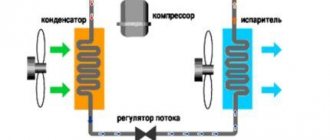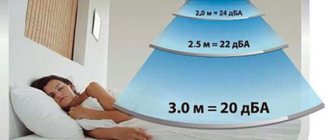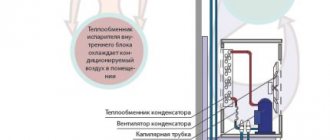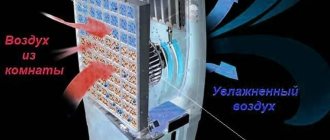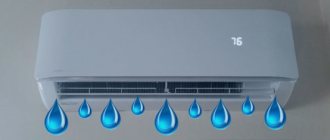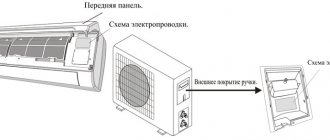We were wondering how to drain condensate from the air conditioner into the sewer correctly! Let's consider: drainage, check valve and drainage options. About everything in order in this article.
Air conditioning is becoming one of the mandatory elements not only in office or public buildings, but also in apartments or private houses. The operation of this device allows you to normalize the temperature in the room and provide a comfortable microclimate. A specific feature of using the device is the appearance of a significant amount of moisture, which must be removed somehow. The most successful option is to drain condensate from the air conditioner into the sewer. This method requires the creation of a water drainage system that operates according to certain rules.
Review of popular models
Hepvo CV1WH
(Cost: about 1000 rubles). Siphon with a dry water seal (polymer membrane with molecular memory) with a check valve function. Inlet Diameter: 1/2¨ Outlet Diameter: 40mm
McAlpine MRNRV40
(Cost: about 1200 rubles). Siphon with dry water seal (silicone membrane with molecular memory) with check valve function. Inlet Diameter: 1/2¨ Outlet Diameter: 40mm
Hutterer & Lechner HL136.3
(Cost: about 3000 rubles). Siphon with mechanical locking device, with horizontal outlet and dirt collector. Threaded connection diameter: 5/4¨ Outlet diameter: 40mm
Results
In order not to disturb neighbors and passers-by with condensation dripping from a height, take care to install a drainage valve, it is also called a siphon. A check valve for air conditioners in the sewer will remove excess water into the drain, saving you from unnecessary problems.
When choosing a siphon, pay attention to its technical and operational characteristics. Still have questions? Ask them in the comments below. Well, if you have previously purchased or installed a siphon with a shutter, share your experience. It will be useful for many readers of our site. Good luck!
Source
Types of siphons
Modern industry offers a range of siphon models aimed at making room air conditioning as comfortable as possible and condensate drainage absolutely safe for the environment. The entire set of models can be divided into two groups:
- Siphon with water seal.
- Dry siphon.
A special feature of a siphon with a water seal is the presence of a compartment filled with water, which is located in the lower part of the device and connects vertically standing pipes. Due to the constant presence of water in the compartment, any penetration of odors into the room is suppressed.
Siphons with a dry seal have several advantages, since they do not freeze, water cannot dry out in them, and the water seal does not break.
general information
During operation of the air conditioner, condensation forms in the system. It is collected in a drain pan, from where it is then removed from the indoor unit through a drain tube. In most cases, the drainage pipe goes directly to the street. You've probably noticed more than once how an air conditioner hangs on the facade of a house and water is literally dripping from it. Such situations often lead to conflicts with neighbors.
And such a “straightforward” method of removing condensate is prohibited by SNiPs. Water will flow not only onto the neighbor’s balcony, but also onto the facade of the house, as well as onto the heads of passers-by. And if the air conditioner is installed in a country house, then over time the water is guaranteed to destroy the blind area. It’s not for nothing that they say that water wears away stones.
To solve this problem, the drainage pipe must be taken not to the street, but to the sewer. For these purposes, a non-return valve is used or, as it is often called, simply a siphon with a shutter. This simple device is necessary for the smooth removal of condensate, while neither foul odors nor gases hazardous to health will penetrate into the room.
Kinds
There are several types of dry siphons. You can choose a device for a bathtub, washing machine, shower tray, kitchen, air conditioner and other appliances.
- Membrane. This siphon is distinguished by its unusual internal design: inside the pipe, which serves as a protective housing, there is a spring-loaded membrane. When water pressure is applied to it, the spring is compressed, thereby clearing the way to the hole in the plumbing system that goes into the sewer. This opens up a clear path for wastewater to pass through. If the water is not turned on, the spring is in its standard position and ensures the tightness of the siphon.
- Float This model is a symbiosis that combines some of the functions of dry and conventional siphons. The design itself contains a vertical outlet and a float valve (hence the name). When the water seal is filled with water, the float, staying afloat, ensures the passage of waste. If there is no water in the siphon, then the float lowers and blocks the hole into the sewer.
- Pendulum. In such a plumbing element, the valve is located at one point. Water flows passing through the siphon exert pressure on the valve, and it, in turn, deviates from its axis under pressure. When the liquid does not pass, the valve, which works on the principle of a pendulum, clogs the sewer hole.
Among the most popular manufacturers of dry siphons are Hepvo and McAlpine. Models of these brands are considered the highest quality products on the plumbing market. Their cost may vary (prices start from 1,000 rubles).
In the line of these manufacturers you can find dry siphons for any need, as well as devices suitable for various types of plumbing fixtures.
Varieties
There are several types of air conditioner drain check valve on the market. Let's look at the main ones.
With water seal
This is a standard type of siphon. It has a U-shape and performs one single function - it protects against the penetration of toxic gases, while removing excess condensate into the sewer. This siphon has several key disadvantages.
Firstly, its dimensions can hardly be called compact: the height of the device can reach 30 centimeters! Secondly, the siphon does not always cope with blocking unpleasant odors. Thirdly, bacteria actively colonize such a device due to its design features.
But a siphon with a water seal is inexpensive, easy to install and just as easy to replace with a new one if necessary.
With valve to prevent the spread of odors
This is the most common variety that we recommend for installation. Such siphons are compact, equipped with a water seal, as well as a special drain valve that does not allow foul odors into the room. Also, such devices are equipped with a chamber into which dirt is collected. The siphon is easy to maintain, which means it will last longer.
Dry
A dry siphon is a so-called check valve for drainage. It is an elastic pipe that is almost always closed and does not allow odors and toxic gases to enter the room. As condensate passes through, the tube opens, discharging excess water into the sewer system, and then closes again.
In our opinion, it is the most technologically advanced and convenient valve of all the above. And that's why:
The size of a dry siphon is significantly smaller than a conventional device with a water seal;
Siphon materials do not contribute to clogging;
Blocks unpleasant odors and toxic gases from the sewer;
Resistant to low temperatures;
How to choose
In order not to make a mistake with your choice and purchase not only a high-quality model, but also the specific siphon that will meet your individual needs, you should listen to the advice of experienced specialists.
First of all, it is recommended to pay special attention to the diameter of the water seal. In order to be able to provide optimal throughput, and also depending on the type of device to which it will be connected, the siphon must have one or another nominal diameter
For example, for a sink this figure should be at least 50 mm (50x50), and for a shower - 2 times more. If in your bathroom several plumbing fixtures are located next to each other (or opposite each other in adjacent rooms), then each of them must be provided with a separate device. In order to install the siphon for a dishwasher or washing machine as comfortably as possible, it is worth purchasing models that can be installed sideways.
The dry type model is not suitable for installation on a kitchen sink, due to the rather contaminated grease drains. For such a plumbing product, it is better to choose a bottle-type siphon, which is water-based. You should take into account the fact that siphons often require a gap (this is especially true for devices that are installed for the shower drain). Remember that siphons with a horizontal device do not need a large headroom, but for vertical ones a gap of at least 15 centimeters is required.
The purchase of a device should be made only in official stores or representative offices and only from trusted sellers.
Detailed information about the Hepvo dry siphon is in the next video.
Criterias of choice
To choose the right siphon, consider not only the operational, but also the technical characteristics.
Diameter _ The siphon has an inlet pipe. Its diameter cannot be selected by eye. Consider the diameter of the drainage tube. It should be the same as the diameter of the siphon inlet pipe.
Dimensions . One of the most important points that many people forget about. The siphon should fit into the space that you have allocated for it. If this is a hidden valve, then pay attention to the thickness of the wall so that the width of the siphon box does not exceed the permissible limit.
Bandwidth . _ Everything is simple here: the more powerful the air conditioner and the more often it is used, the higher the throughput of the siphon should be. The device must cope with the flow of condensate, otherwise problems may arise. If in doubt, it is better to immediately take a siphon with increased capacity.
Tightness . A high-quality siphon must be equipped with special rubber seals. They will ensure the tightness of the structure. Otherwise, water or unpleasant odors may enter the room.
Price . Cheap is rarely quality. You should not skimp on either the siphon or other components for the air conditioner. There is also no need to skimp on installers. After all, the efficiency of the siphon and the air conditioner as a whole largely depends on the quality of installation.
Purpose of the product
The operating principle of the air conditioning device is based on absorbing water from the air, which is why condensation occurs. Moisture remains on the cold plates of the heat exchanger, which is then collected in a special container - a drainage pipe. Therefore, it is believed that if water drains from the air conditioner (external tank), then this is its normal operating condition.
The constant dripping of water from the external drain pipe of the air conditioner does not bother many of its owners at all - it’s not dripping in the apartment. However, this situation can have many negative consequences:
- Constant dripping of water, especially when installing an air conditioner in a private house, can harm not only the blind area, but also the foundation of the building.
- When installing an air conditioner in an apartment building, dripping water can cause problems for the residents of the lower floors. Hardly anyone will be happy to listen to the constant knocking of drops on a window sill, balcony, or the wetness of the external wall of the apartment.
- The very sight of an air conditioning device with water dripping from it is not particularly pleasing to the eye.
- There are problems with using an air conditioning device in winter, since the liquid in the drain pipe may freeze and, as a result, break down the air conditioner itself.
In addition, the European Union has already completely banned the installation of air conditioners that allow condensation to enter the external environment. Domestic legislators may soon become concerned with this issue.
Regulations governing the drainage of air conditioners
There are SNiP and SanPiN standards that prohibit the discharge of condensate into the street through a hole in the outer wall. This option for removing moisture has a lot of negative consequences:
- destruction of the building's load-bearing structures;
- spread of pathogenic bacteria;
- contamination of the facade of the building and windows located near the drain point.
An additional factor is the sound of falling drops, distracting from business and preventing neighbors from resting at night.
The recommended removal option is to drain the condensate from the air conditioner into the sewer system. This method allows you to avoid all the undesirable consequences of moisture settling on the air conditioner evaporator.
There is another prohibition of current regulations. It refers to the removal of generated moisture into storm drains. The reason for this limitation is the instability of the storm drain - during heavy rain, significant pressure is created in it. Because of it, water can rise through the pipes and damage the air conditioner. In addition, stormwater runoff can enter residential areas.
There are often allegations of the adoption of a law prohibiting the drainage of split systems into the street and requiring the discharge of air conditioner drainage into the sewer. However, it turned out to be impossible to find him. It seems that resolving the issue at this level is an excessive measure. The current SNiP, SanPiN and one’s own understanding of the need to comply with these standards are quite sufficient.
Purpose
A siphon for a split system is a special device that connects the condensate outlet pipe to the sewer system. The main purpose of the device is to remove moisture from the air conditioner into drain lines and protect the premises from the unpleasant smell of sewage. Moreover, the use of a siphon provides aesthetics to the exterior of buildings by preventing water from flowing onto walls and sidewalks. At the same time, along with the aesthetic component, there is also a practical one.
Thus, water dripping from the outlet pipe forms puddles and excessively moistens the blind areas of houses. This, in turn, negatively affects the foundation and eventually leads to its destruction. In winter, air conditioners that are not equipped with a siphon run the risk of failure due to freezing of condensate inside the drain tube.
Self-production
In stores, siphons for drainage from an air conditioner cost from one and a half to two thousand rubles, and many users are thinking about making such a device themselves. Opinions on this matter are contradictory: some say unequivocally that it cannot be done - just buy it cheaper. But there is also the opposite opinion.
There are two options for homemade water seals:
Option No. 1. Without using special tools at home, you can bend a U-shaped pipe. Connect one end of it to the air conditioner, and insert the other into the sewer pipe. Such a device will pay off only when the split system is constantly in operation. But if the air conditioner is idle for a long time, the liquid will evaporate from the elbow of the device, and foul odors from the sewer pipe will fill the room.
Option No. 2. This method of making a dry water seal for wall or ceiling placement of an air conditioner. What is its essence? For such a homemade device, you will need a compensator (an ordinary plastic pipe with a narrower diameter of about 60 mm). A double-sided rubber cuff (from a washing machine) with a trimmed collar is inserted inside it.
A tennis ball is placed on top of the cuff hole. The lower part of the pipe is inserted into the sewer pipe, and a hose is inserted into the upper hole to drain condensate from the air conditioner. The principle of operation of such a dry water seal is as follows.
During operation of the split system, moisture is released from the heat exchanger, capillary tubes, radiator and other elements. Gradually, through the drip funnel of the outlet from the air conditioner drain, it flows down the outlet hose into the exposed compensator. The ball rises under the pressure of drainage fluid from the air conditioner, freeing it to drain into the sewer line. After the pressure from the condensate decreases, the ball moves into place under its own weight and tightly closes the hole.
You can watch the video for more information about making a dry water seal yourself:
Check valve for air conditioner drain system
Siphons for connecting the drainage of split systems to the sewer system differ from similar devices for bathtubs and sinks. Their operating principle is not based on creating a water seal, but on the use of a check valve. Such a valve completely blocks air and drains from the sewer, but at the same time freely allows condensation from the air conditioner to pass through it.
The design of the drainage siphon is quite simple and most often is a device of one of two types:
- Ball valve. A light plastic ball plays the role of a kind of float, which rises when water moves towards the sewer and falls when there is no sewer or when it moves in the opposite direction, blocking access to unpleasant odors and drains.
- Spring valve. It works in a similar way, but instead of a ball, the device uses a membrane connected to a spring. Water from the drain hose stretches the spring and moves the membrane, allowing it to flow into the sewer. In the absence of water flow, the spring returns the membrane to its previous position, at which the siphon becomes closed.
In addition, depending on the installation and maintenance parameters, the valve for draining the air conditioner into the sewer can be:
- Whole. It has a non-separable body, so it requires periodic replacement (every 2-3 years).
- Segmental. It is a dismountable device and requires only regular maintenance and cleaning.
- Wall. It has compact dimensions and an ergonomic modern design, designed for installation of the device in a visible place. The case has holes for wall mounting using self-tapping screws.
- Mortise. Used to connect the drainage hose directly to the sewer pipe.
How to properly get rid of condensation
- The most common and cost-effective, but not the best or most correct, method is to simply lead the drain pipe out of the window through a hole in the wall.
The advantages are obvious - drill a hole, lay a hose and you're done. The negative aspects are the effect of “raindrops” that drum on the window sills, and the higher the height, the louder the knocking. Such a decision is fraught with a showdown with an angry neighbor who is being disturbed by your “drum set” from sleeping. The aesthetic side of the implementation should also be noted as a disadvantage - pipes hanging on the wall do not add beauty to the interior of the room at all. On a note. Modern editions of SNiP and SanPiN prohibit drainage through the wall. It is also prohibited to crash into a storm drain - during heavy rainfall, the pressure in the storm drain will be so strong that the reverse flow of water from the drain will flood the room. This happens when the LC cannot cope with the flow of rain and is completely filled along its entire length - then the pressure in it reaches its maximum value. - It would be much more efficient to drain the condensate from the air conditioner into the sewer.
This option solves the disadvantages of the first method - waste from the unit is discharged into a network specially designed for this purpose. This can be either the general sewer system of the building or a specially laid pipeline network. The drainage of wastewater is carried out either by gravity, due to the negative slope of the pipes, or using a pump.It is worth paying attention to some nuances when discharging into the general sewer system:
To prevent the penetration of unpleasant odors from the pipe into the room, it is necessary to install a water seal - a part of the drainage pipe curved in the shape of the English letter S. The water that will remain in the lower leg will create an insurmountable barrier to the “aromas from below.”
- If gravity flow is used, be sure to calculate the minimum required diameter and slope of the system so that all condensate flows freely through it.
There are split systems that use part of the condensed moisture to maintain the balance of air humidity by evaporating the liquid in the heater. It should not be forgotten that preventive maintenance of the drainage system should be carried out at least once every three months. Even if the air conditioner did not work during this entire period, nothing prevented dirt from accumulating and pathogenic organisms developing in all its nooks and crannies.
Installation of drainage system
A flexible hose is laid from the drainage hole of the indoor unit of the air conditioner. To place it, a groove is punched into the wall.
The line should not make sharp turns; they prevent the uniform flow of liquid. Let's assume an angle of 45°.
Before entering the sewer pipe, a siphon with a water seal is installed to cut off unpleasant odors. Installation is carried out using crimp nuts. The direction of flow is marked on the body of the unit. The arrow helps identify the inlet and outlet. The connection to the sewer network is made with a flow break. After installation, the system is tested.
What is drainage, where does condensation come from in an air conditioner?
Drainage is a special system for removing condensate that forms on the surface of the evaporator as the temperature of the refrigerant changes. Droplets of water appear on the surface of the evaporator, which flow into a special tray. The pan has a hole equipped with a common drainage pipe. Therefore, pallets are most often made with inclined planes towards the center.
Polymer corrugated tube leading out from the storage tank
| Important! Drainage can also be called the tube itself for removing moisture, and the drainage system can be a whole set of tubes that is used to remove moisture outside the block. |
As a rule, tubes are made of a polymer material - polystyrene or copper. The use of these materials guarantees lightness and airtight construction.
Installation of Siphon PROFcool SCU-032
Installation of a siphon to collect condensate from air conditioning systems
Features of installing a siphon in a wall recess
- The siphon body is mounted in the wall recess strictly vertically, so that the inscription “UP” is on top. The vertical distance from the air conditioner outlet to the siphon must be at least 250 mm.
- Pipelines are connected to the inlet and outlet pipes.
- Before sealing pipelines, carry out hydraulic tests in accordance with clause 4.15 of SNiP 3.05.01-85 “internal sanitary systems”.
- The front siphon cover must be closed to avoid scratches during finishing.
- After testing and completion of the wall, the top of the mounting box is cut flush to the wall surface along the recessed ribs.
- The cover is then cut along the nearest recess on the ribs and closed with spring clips to the bottom of the mounting box.
Features of installing a siphon on top of a wall (for example, in a sewer shaft)
- The siphon is mounted directly on the wall. It can be installed either in a mounting box or without it. Access to the installation site is required for further maintenance of the siphon. The vertical distance from the air conditioner outlet to the siphon must be at least 250 mm.
- Pipelines are connected to the inlet and outlet pipes.
- It is necessary to carry out hydraulic tests in accordance with clause 4.15 of SNiP 3.05.01-85 “internal sanitary systems”.
Overview of siphon for collecting condensate from air conditioning systems
Description of the siphon
Built-in siphon for collecting condensate from air conditioning systems, vertical, with a 93mm high water seal and a mechanical odor-locking device that does not allow odor from the sewer when the water dries in the water seal, with a decorative cover. Inlet pipe Ø32mm for soldering PP pipes with an elastic adapter for connecting pipes Ø16, Ø20, Ø25mm. Outlet pipe Ø16, Ø20, Ø32mm.
Siphon equipment
- The lower part of the mounting box is 166*120*42mm (H*W*D) made of UPS.
- The upper part of the mounting box is 176*130*48mm (H*W*D) made of UPS, which has a decorative cover 176x130mm cut to the level of the plaster with spring clips for fastening to the lower mounting box.
- A collapsible siphon with a water seal and a mechanical odor-locking device - a ball, made of PP.
Technical characteristics of the siphon
- Connecting dimensions: Input Ø16, Ø20, Ø25, Ø32mm, Output Ø16, Ø20, Ø32mm.
- Weight: 0.35 kg.
- Throughput: 0.09 l/s.
- Service life: at least 50 years.
Siphon operating principle
When draining drainage from air conditioning systems, water passes through three pipes, hermetically connected to each other using sealing gaskets and corners. The pipes have a water seal 93 mm high and a mechanical odor-blocking device in the form of a ball, which, when the water seal dries, does not allow odors to escape from the sewer.
Types and their characteristics
Siphons for air conditioners are classified according to two criteria: by type of design and by method of liquid drainage. According to the first criterion, 4 types of devices are distinguished.
Siphon with water seal
The device has a classic U-shaped design and consists of 2 tubes connected to each other by an elbow. A layer of water is constantly present in the knee, providing a water seal effect. The advantages of such a siphon are simplicity of design, large outlet diameter of 40 mm, low cost and transparent design of the tubes, which allows you to visually monitor the liquid level. The disadvantages include some cumbersomeness of the device and the risk of fungus and mold growing in it, which over time can spread to the split system itself.
When the split system is used infrequently, the water in the elbow begins to dry out, and the siphon becomes a source of unpleasant odors. To prevent such situations, for example, a washing machine is additionally connected to the siphon, due to which the water seal is regularly recharged. The optimal height of fluid in the knee is considered to be 140-320 mm.
Siphon with water seal, equipped with odor-locking valve
Structurally, the model resembles the previous one, however, it is additionally equipped with a small valve, made in the form of a ball, which limits the spread of unpleasant odors from the body. The valve only works in one direction, allowing water and air to flow freely into the sewer system and blocking their reverse movement. The principle of operation of such a siphon is as follows: under the influence of water pressure, the ball rises upward and ensures the free flow of liquid into the sewer. When the flow weakens, the ball, due to its own weight, lowers and blocks the outlet pipe. Ball models are additionally equipped with a dirt collector chamber, which collects solid particles washed out of the pipes by condensate.
Concealed siphon
A special feature of this type is the presence of a plastic box in which the device is located. Liquid supply and drainage tubes are connected to the box, and the siphon itself has a float type design with a ball odor-locking valve. The model assumes vertical built-in installation and is installed in the wall. The siphon body often has a transparent design, which facilitates visual inspection of the water seal. Moreover, the siphon cassette can be easily removed from the box and, if necessary, cleaned of dirt.
Dry siphon for ventilation and air conditioning systems
Installed in cases where it is not possible to connect a traditional device. The device is equipped with a rubber tube that perfectly inhibits the spread of unpleasant odors. The passage of condensate occurs according to the drip principle: as water moves, the valve opens and then contracts again. Dry siphons are used in combination with straight adapters and funnels.
The advantages of dry siphons are the absence of the risk of freezing, evaporation of condensate and failure of the water seal. In addition, unlike traditional models, such samples do not require constant replenishment with condensate and regular maintenance, and are also not prone to the formation of mold and mildew. Dry siphons are compact in size and do not clog, and the drip principle provides high throughput. The latter property is due to the absence of elbows and direct fluid flow.
According to the second classification criterion - the method of liquid discharge, siphons can be vertical, horizontal and combined. Vertical drainage is typical for models with hydraulic seals, while dry-type samples can drain liquid using a horizontal or combined method.
Siphons with a jet break should be highlighted in a separate category. This system provides for a break in the condensate flow, which becomes possible between the outlet pipe from which the condensate flows and the receiving pipe. In other words, there is no direct contact between the incoming liquid and the water seal. Water drips from a height of 2-3 cm into the funnel, where it enters the water seal, and when it overflows, it goes into the sewer system. This prevents the penetration of microbes from the sewer pipe into the room and allows several liquid discharge pipes to be connected to one funnel.
Condensate drain options
There are several ways to drain air conditioners. The simplest one is to make a hole in a wall or window and pass a hose through it to the street, which at one end is connected to the pipe of the bath located under the evaporator of the indoor unit of the unit. It is the simplicity of the operations performed that is considered a big advantage of this method.
But it also has negative sides:
- a hose hanging from the side of the wall does not in any way increase the presentability of the appearance of the building, especially for a private house;
- Water will constantly drip from the free end of the hose while the air conditioner is operating, which, if it gets onto the adjacent window sill (lower), will lead to a scandal with the neighbors.
The second option for draining condensate is to connect the drainage pipe to the sewer. The method is ideal for many rooms, but it has one big problem - the lack of a sewer section in the room where the indoor air conditioner unit is installed. Way out:
- Install sewer pipes into this room with a slope of up to 3%.
- Install drainage pipes to the nearest sewerage section with the same minimum slope.
Which option for draining condensate from the air conditioner into the sewer system is up to everyone to decide for themselves. But it is necessary to indicate that the lowest costs, both in terms of finances and in terms of the labor intensity of the work carried out, belong to the second method. Firstly, drainage pipes can be laid both inside the wall along the grooves made, followed by sealing with repair solutions, and along the floor base, followed by finishing.
Secondly, any sealed hollow products can be used as drainage tubes. More often, a corrugated pipe of small diameter is purchased for this.
Attention! To prevent unpleasant odors from penetrating into the premises from the sewerage system, a water seal in the form of a conventional sewer siphon is installed at the junction of the drainage pipes and the sewerage system pipes. If it is not possible to install a siphon, then the corrugated tube is bent in the shape of the letter “S”. Also an effective option
Also an effective option.
And one moment. If the air conditioner is not used for a long time, the water seal dries out, which leads to the penetration of unpleasant odors from the sewer. Therefore, periodically it is necessary to pour a little water into the drainage system. And this is probably the only disadvantage of this method.
The third option for condensate removal is the installation of a special pump. This drainage method is used only in two cases: the drainage system is long and there are differences in it. In household air conditioners, pumps are not included in the package, although they are sold as a separate element, and purchasing it and installing it will not be difficult. In almost all industrial units, drainage pumps are installed at the factory.
Pumps are necessarily included in the standard package of cassette and duct air conditioners. There are pumps that are installed in external units, but more often they are installed in internal ones. They are usually equipped with an additional container in which condensate is collected. And the pump pumps out liquid from it.
Types of siphons
Devices are classified according to two criteria: design and method of removing moisture.
Arc-shaped model with water seal
The standard version is bulky in size. The height of the water seal should be between 140-320 mm. The pipes are made transparent for visual inspection. Outlet diameter 40 mm. To recharge the water seal, it is possible to connect a washing machine. The model is recommended for high pressure or vacuum in the drainage pipeline. Among the disadvantages of the unit: large size, favorable environment for the development of bacteria, the likelihood of drying out.
Design with water seal and odor-locking mechanism
Compact option, designed for hidden and open installation. The unit is equipped with a water seal and an odor-locking mechanism in the form of an ABS ball. When the water seal level drops, the shut-off valve closes the outlet pipe. The model is equipped with a cleaning chamber for collecting dirt. The entrance to the siphon is vertical or horizontal, pipe DN32. Horizontal outlet DN40.
Concealed system
Siphon for hidden installation with vertical connection
The siphon assembly for draining the air conditioner into the sewer is hidden in a plastic box. The unit body is installed in the wall. Placement type: vertical, water seal height 50 mm. Case size 100x100x60 mm. Two pipes are connected to the box - an inlet pipe and an outlet into the sewer. It is possible to connect drainage hoses of three diameters: 20, 26, 32 mm. Inside the case there is a transparent cassette with a water seal and an odor-locking device. The valve opens when condensate passes through and closes when the water leaves. The cassette is replaceable; you can remove it yourself and clean it of dirt.
The set includes a construction plug and a decorative cover with spring clips. When choosing the installation location, the requirement is taken into account - the minimum distance between the outlet pipe of the split system and the siphon is 2 m. To service the unit, it is enough to remove the decorative cover.
Dry aggregate
Using a water seal is a simple and cheap solution to the problem of blocking unpleasant sewer odors. Without regular renewal of the water barrier, its benefits disappear.
The most common option is an elastic tube with molecular memory. In its normal state, it is closed and blocks sewer gases. As water passes through, the tube opens and then returns to its original shape. Advantages of dry shutter:
- compact size;
- thanks to the smooth surface of the membrane or tube, the device does not become clogged;
- serves as a reliable barrier to the spread of odor from the sewer;
- does not freeze in winter;
- the absence of elbows ensures high throughput;
- Vertical and horizontal installation is acceptable.
A dry siphon is used not only for draining air conditioners; it is installed under bathtubs and sinks in the country.
The second classification point is the method of condensate release:
- vertical release;
- horizontal release;
- combined option.
Main manufacturers
Hutterer & Lechner
The leader in the production of siphons for air conditioning systems is the Austrian company Hutterer & Lechner (HL). The products are distinguished by high quality and simplicity of design. The technology of equipping the units with a water seal and a locking ball valve prevents the appearance of unpleasant odors. The company offers siphons of various models:
- HL 136.2 - siphon with water seal;
- HL 138 - built-in system;
- HL 136 N is a unit with a water seal and a ball odor locking device.
Vecamo
The Italian company Vecamo offers a siphon for air conditioning, which is mounted on the wall, providing free access to the inlets and outlets. The kit includes connectors designed for drainage hoses of various diameters. The transparent plastic case allows you to monitor the condition of the internal part.
McAlpine
The self-closing drain valve or dry siphon of the MacValve series from McAlpine is produced in two installation sizes: 32 and 40 mm. The compact plastic case contains a polymer tube that functions as an odor-blocking device. Vertical installation is recommended, but horizontal installation is acceptable. In the first case, the throughput is 1.58-275 l/s, in the second it is lower - 0.7-1.7 l/s.
The design of siphons with a check valve for draining condensate into the sewer system was thought out by professionals. It is not possible to make such a device yourself. The only available option is a simple design with an elbow and a water barrier that can dry out at any time.
Purpose of the device
Running a drainage hose outside through a hole in the wall is the easiest way to remove condensation. A flexible tube 80 cm long serves to drain the resulting moisture. A simple and affordable option has its drawbacks: it is prohibited by SNiP, drops fall on passers-by, and in winter the drainage pipe freezes. In a private house, erosion of the blind area is added. The optimal solution is to connect the air conditioner to the sewer. An indispensable condition for proper installation is the installation of a siphon with an odor-locking device. It allows liquid to pass in one direction and prevents not only odor but also dangerous gases from entering the room.
Options for discharging water from the air conditioner
There are several popular methods:
- condensate discharge to the outside through a hole in the wall . The most common solution to the issue, but also the most incorrect from the point of view of the current rules and ordinary ethics;
- collecting moisture in a special tank . A more acceptable method, but it requires constant monitoring of the water level in the tank;
- drainage from air conditioners into the sewer system . This is the most complex and most correct method of removing condensate in all respects.
The first two options are used most often. Water discharge to the outside occurs everywhere. The first air conditioners were all installed in this way, control over compliance with standards was introduced later and no significant changes have yet been observed. The use of special containers to receive moisture solves the problem only until the volume is overfilled. If the moment is missed, water spills onto the floor or other surfaces. In an apartment building, this situation is fraught with flooding of neighbors and constant conflicts.
Main types and design features
A classic siphon can be seen under every sink located in the kitchen of our apartment. It can certainly be used to drain drainage water from the split system into the sewer, but the device is too bulky and takes up a lot of space. That is why many manufacturers of such devices have taken the path of reducing their dimensions, due to which the following types of devices have been developed:
- The classic and simplest drain siphon for air conditioner condensate has a U shape. The elbow connecting the inlet and outlet pipes of this device plays the role of a water seal. The device is easy to install and maintain, but has several serious drawbacks: the water in the elbow can evaporate if the air conditioning equipment is not used regularly, and unpleasant odors can enter the room. The second disadvantage is that such a drainage unit takes up a lot of space. As a rule, it is installed in specially prepared wall niches, covered with decorative panels.
- Siphon for air conditioner drainage
with a water seal and a mechanical ball valve that prevents odors from the sewer system from entering the room. This type of device can be used for both external installation and internal (built into the wall) location. The ball valve opens due to the pressure of drainage water on it. When the flow decreases, the valve closes the outlet to the sewerage system, preventing the movement of fecal water in the opposite direction.
A special feature of such units is the presence of a dirt collector in their design. The ball valve prevents the movement of water and unpleasant odors.
- For hidden installation (wall installation), box-shaped models with a ball float valve as a locking mechanism are most often used. The ball valve floats up when condensate enters the device, allowing water to pass freely into the sewer.
When water circulation in the device stops, the float, under its weight, blocks the drainage channel, creating a barrier to the penetration of odors from the sewer system. The float siphon for air conditioning, with its small dimensions, completely replaces the standard U-shaped drainage device. The box-type drainage units have a replaceable cassette, which, if dirty, can be changed or cleaned independently. The cassette is made of transparent plastic, which makes it possible to control its degree of contamination.
Peculiarities
A dry siphon is nothing more than a pipe (and it can be vertical or horizontal). The siphon body can be made of plastic or polypropylene. At both ends of the tube there are special threaded shanks for fastening: one of them is attached to a household appliance, and the other goes into the sewer system.
The inside of the siphon contains a special device with a shutter that works like a valve. It is thanks to this design that the smell from the sewer does not pass into the room, since it blocks the cross-section of the siphon pipe.
This characteristic of a dry siphon is especially important in case of blockages and contamination (especially for those consumers who live on the first floors of apartment buildings): in the event of a breakdown of plumbing equipment, contaminated and unpleasant-smelling liquid will not flow into the room.
In addition to all of the above, several more features of the dry siphon should be noted, which are highlighted by regular users of this plumbing design.
- A dry siphon is a durable and reliable device. Its operation proceeds without complications; regular checks, cleaning or maintenance are not required. In addition, it retains its functionality for quite a long period.
- For proper and high-quality operation, almost all subtypes of siphons require the presence of water. Dry type construction is an exception to this rule.
- The device can be installed even in rooms that are not heated during the cold season.
- The material from which the dry siphon is made has anti-corrosion properties.
- The device is manufactured in accordance with the requirements of Russian standards, it has all the necessary licenses and certificates of conformity.
- Installing this design is a fairly simple process, so even a beginner can do it.
- Due to its compactness, as well as the possibility of both horizontal and vertical installation, the siphon can be installed even in complex plumbing systems in a small space.
- The internal design of the device prevents the constant accumulation and stagnation of water inside the pipe, and therefore is able to protect residents not only from unpleasant odors, but also from the appearance and proliferation of harmful bacteria and microbes.

